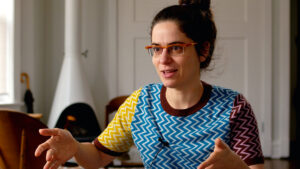It’s a brave soul that dares offer advice to the opposite sex these days. Women authors tend to stick to listing men’s flaws so that female audiences can enjoy the resulting catharsis. Men are pretty much banned from making any generalisation about women, good or bad.
But Times columnist Caitlin Moran is bolder. With her new book, What About Men?, she goes where few women have gone before. Having noticed that young men seem to be in crisis, she now attempts to get inside the mind of the modern male in order to help him out.
Early signs suggest that it’s not going down brilliantly with the Other Side; even the Times reviewer has reservations. And the Twitter commentariat is enjoying posting outraged screenshots of excerpts. “Patronising”, “shallow” and “one-dimensional”, have been some of the verdicts from men so far.
I’ve read the book, and though the intentions behind it are admirable, I agree that it has problems. Moran apparently thinks not just that masculinity is wholly cultural, but that there’s only one version of it, entirely based on her husband, his mates, and some sons of her friends. Every bloke in the world likes rock music, wears disgustingly decrepit gym gear and won’t talk to his friends about fatherhood or relationships. Equally, she seems to think that all women are exactly like she is — dorky, warm, garrulous and funny. They dish out copious tea and sympathy, enjoy avid discussions of pop culture and bodily functions, and bond over how terrible the Seventies were.
She reduces the issue of whether any behavioural differences between the sexes are partly due to biological factors, to the straw man of whether there are “massive differences between male and female brains”, ignoring the potential influence of smaller brain differences, or of pre-natal and circulating sex hormones. (And this in a section where, two pages later, she observes without any apparent sense of tension that “girls develop their fine motor skills earlier than boys”.) She flat-out denies that there are “any major differences in the language skills of boys and girls”, ignoring swathes of evidence that suggest otherwise for early childhood. I’m not saying such questions are definitively settled in either direction, but it smacks of laziness to pretend they are.
She also takes a “creative” approach to explanations of behavioural difference, as exemplified by her Just-So story of how the male conversational style developed (that is: heavy on banter and technicality; light on in-depth analyses of the couples on Love Island). Boys start school at a disadvantage to girls because they can’t hold a pen. A catastrophic chain of developmental events then unfolds, according to our author. While girls race ahead with their communication skills, boys lose confidence, start reading comic books rather than Little Women or Anne of Green Gables, and take refuge for their lack of ability to understand the social world in jokes about gay people, and descriptions of the internal combustion engine. For the unreconstructed sexist who suspects that women should steer clear of scientific explanation, Moran’s approach here is unfortunately likely to serve as further confirmation.
And then there’s the relentlessly ribald writing style. I’ve never positively wished for sensitivity readers and trigger warnings before, but there’s a first time for everything. Demystifying sex for the reader is one thing; making him grimace so hard his face seizes up, another. If, as Moran seems to think, bedroom preferences are formed by exposure to certain scenarios early on in life, hers seem to have been shaped by reading too many Viz magazines. I came away from the book mostly thinking we need to Make Sex Sexy Again as a matter of national emergency.
For instance, on women (and I apologise in advance for this), “if we’re very ‘vocal’, and loud, during sex – ‘YES! YES!’ – it might be because we’re aware we’re doing fannyfarts, and don’t want you to hear the party vag-sounds that are happening ‘down there’”. Male ejaculation is “Nature’s splendid custard-y firework display”. Whereas men allegedly never discuss their genitalia, we women “tell each other, constantly, to rejoice in our minges” (we do what?). Moran recounts how she once spent a whole afternoon, stoned, talking to her husband’s testicles and “seeing how they reacted to my varying chats”. (Spoiler: they shrivelled). If this prose is really aimed at teenage boys as it sometimes pretends to be, let’s just say that the birth rate is not likely to improve anytime soon.
Other parts are more successful. She is right that young men increasingly struggle with body image issues, that most internet pornography is violent and soul-destroying, and that false whispers about sexual misdemeanours can ruin a young man’s life. She tries hard to be sympathetic about all this, as well as to the idea that young men are beset by images of “toxic masculinity” in a way that is messing them up. And there’s even the odd hint that prevalent feminist approaches might be part of the problem — including her own in previous books.
Post #MeToo, one legacy of mainstream feminism seems to be the policy of shouting at all men about how terrible they are, in the hope that some of the generalised opprobrium sticks to the right candidates. At the same time, men’s ordinary sexual impulses — sometimes irritating, sometimes welcome — are denigrated and treated as inevitably threatening and sinister.
No finer example can be found than in a National Rail poster campaign running at the moment, which thunders: “INTRUSIVE STARING OF A SEXUAL NATURE IS SEXUAL HARASSMENT AND IS NOT TOLERATED.” Everyone knows which biological sex this sinister pronouncement is aimed at (hint: it’s not the one batting her eyelashes furiously at you over her free newspaper).
The fallout from the new puritanism means that sensitive, empathic young men often feel terrible about any sexual behaviours not formally agreed with a partner in writing beforehand; while society continues to do nothing meaningful to stop the sort of hardened offenders unlikely to be influenced by poster campaigns in trains. Youthful coping strategies in response to all this undifferentiated guilt-tripping may include heading towards Andrew Tate videos or heading towards the gender clinic, but either way a different and more nuanced way of doing things would be a lot better.
And it would also be good if we could talk more about what is wonderful about masculinity, and toxic about femininity, without caveats or excuses. When, in the final chapter, Moran eventually gets round to the former, she makes a good stab at it — though, by her own admission, most of the things she thinks we value in men are also things we value in dogs. In fact, I would go further — they are things we value in elderly Labradors. The characteristics she celebrates — being loyal, hard-working, protective, and so on — are all very pro-social and unthreatening to women and children, and unlikely to set the imagination alight of any young man looking for his own hero’s journey.
That young males newly acquainted with massive amounts of testosterone should crave an exciting hero’s journey for themselves is another fact she tries to explain with a Just-So story about acculturation: they’ve read too many comic books about superheroes and “nothing about ordinary teenage boys, trying to learn how to become happy, normal men”. So there you have it — we can combat the allure of Andrew Tate and his ilk by enticing teenage boys to read more boring books. Speaking as a mother of sons who would consider reading comic books a chore when they could be destroying aliens onscreen instead, I’d like to know how she proposes we go about this.
Despite this chapter, throughout most of the earlier stuff, there’s still a barely suppressed sense that Team Woman — or as she has it, Team Tits — has most of the answers, and that members of Team Testicles might get there too if they try hard enough. At one point she suggests, with a characteristically liberal use of italics, that: “Everything that, culturally, is seen as ‘female’, is something anyone can have. These are all things anyone can learn. These are all things anyone can gain. Women weren’t born knowing how to be amazing friends having super-deep conversations about anxiety, and sorrow. Personally, I just learned how to do it from watching The Golden Girls.” Perhaps tellingly, though, there’s little suggestion in the book that women could learn from men about being more loyal or crying less.
Moran is right, of course, that women aren’t born knowing how to understand the complex emotional states of others, in order to be able to listen properly and console them. They need experience, and perhaps also guidance, to activate this capacity. Some women can’t do it at all, while many men can. Still, that doesn’t mean that, across the entire female population, the enhanced capacity of women to understand social relationships isn’t somewhat biologically influenced. To treat feminine traits as a study programme that any man could get up to speed on if he tried seems to be setting men up for failure — and they don’t need more of that.
In any case, perhaps I am female-atypical, but — inviting as it sounds — I couldn’t live in Moran’s smoke-filled, gin-soaked world of warm hugs, tear-stained confidences and frank conversations about bodily fluids for more than 10 minutes at a time. Sometimes, talking about your feelings makes them worse, and sometimes responding empathically to other people’s feelings only makes them more histrionic and attention-seeking. It can be very good to talk, but it can also be very good to shut the hell up and stamp off to dig the garden. As usual, the devil is in the detail. How to Be More Like a Man would be a bold title for any feminist writer, but I’m not sure we should entirely rule it out.
Disclaimer
Some of the posts we share are controversial and we do not necessarily agree with them in the whole extend. Sometimes we agree with the content or part of it but we do not agree with the narration or language. Nevertheless we find them somehow interesting, valuable and/or informative or we share them, because we strongly believe in freedom of speech, free press and journalism. We strongly encourage you to have a critical approach to all the content, do your own research and analysis to build your own opinion.
We would be glad to have your feedback.
Source: UnHerd Read the original article here: https://unherd.com/



